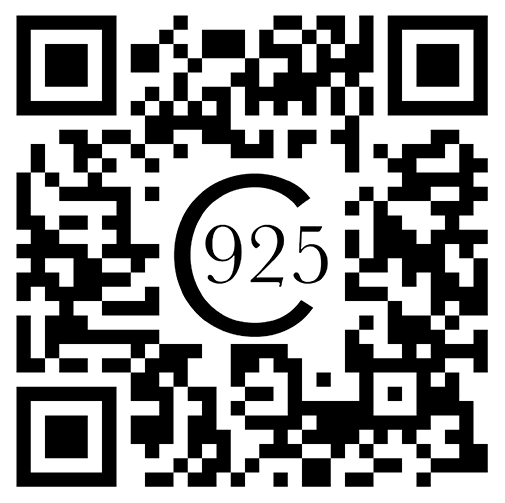Little did I know that my decision to examine the middle joint of one finger would lead to a twenty-year creative exploration that would reveal deep parts of my life for all to see. A personal adventure would ensue, a unique journey.
At first, I noticed that the pointing index finger is a symbol of power. I’d seen a man in a shopping mall point with a fully outstretched arm aiming his finger toward a store across from him. He could have been a majestic Soviet sculpture. When I walked by his finger, I inwardly cringed as if trying to escape a line of fire.
Yet, when I wrap a string, wet with white paint, around the joint and have the model move it in every direction, a marvelous design evolves. In my photograph of the index fingers, on the far left and right, the viewer sees a finger with a ring of wet paint. After the model moves, and she opens her hand, the middle two fingers display a schemata based on her range of motion. This abstraction might be a curving Asian-style calligraphy that looks to me as though it signifies walking on an ascending path from earth to heaven or perhaps a swirling carousel with horses bobbing up and down. I imagine people moving their fingers in their daily tasks – counting money, painting, wrapping gifts, driving – unknowingly creating formerly invisible artistic impressions that, to my eye, appear to spin.
In my image, repeated upright index fingers together have a monumental quality, like four strong Greek columns holding up the Parthenon. These column-like fingers remind me of lofty Greek ideals: beauty, philosophy, democracy. For me, they also bring to mind other truisms important to me: the Four Pillars of Islam or the Four Noble Truths of Buddhism. These provide inner strength to people as humanistic religious precepts that guide billions in their day to day decisions.
When I meditate, I feel an inner connection to many strengths and virtues, particularly Buddhist ideals. In my art studio, I keep a template of my body in meditation. One day, I sat, cross-legged, in front of a large sheet of cardboard and drew an outline of my body in a meditation posture. I cut the image out and I keep this template available. As I let images and ideas evolve in my studio, for the sake of pure curiosity, I often apply designs to myself in meditation to see what will visually happen.

I translate this idea of inner support by superimposing the upright fingers into an outline of my body in a contemplative posture. When I meditate, these fingered columns seem to strengthen me, physically and mentally. They become more crowded in my head, denoting a busy, sometimes obsessive, mind. Yet, their grid-like regularity signifies stability, the source of a peaceful meditation. At the same time, the diagonal lines on the two central fingers reveal the potential for creativity inherent in these potent images. I love the juxtaposition of grid-like regularity, creative fervor, a balance I strive for each day.

In my Tibetan tradition of meditation, the teachers instruct us to visualize a Buddha on the crown of our heads. This spiritual master sends wisdom and healing to us as we say mantras. In this art piece, I place the top meditating guru on top of my head, upside down, head to head, as if we were communicating directly through our minds. I love the hourglass shape the two joined and balanced meditating figures create. This rich symbol reminds me of time going by, the ultimate impermanence of myself and all things. The two figures conjoined represent the duality we all daily experience: inner experience and outer, cold and hot, stability and inventive chaos, me and you, ego and peace.
The two balanced meditating figures remind me that, like all good disciplines, meditation and communion with the divine requires time and effort. It’s worthwhile to make time to stop the busyness of the day and quietly sit and wait for insight. It takes diligence to tame my wandering mind to focus on visualizing the Buddha and repeating the mantra. Many days, my brain would much rather think about the next meal, sex, or a recent emotional upset, justifying my part in it, of course. When I think of the hourglass Buddhas’ image, I laugh at all the pointing fingers, a perfect symbol for my ego that loves to blame others. Looking at the exquisite shape of the hourglass Buddhas, I remind myself to focus on my teacher’s lessons because they balance my normal life’s ego-driven chores with an infusion of divine energy and creative art.
My art evolves over the years. Each iteration taking about five years to morph into the next phase as I allow my subconscious to move me to the next step. Having no idea where it would lead, if anywhere, I began this series by studying one finger. Hesitantly, over a span of twenty years, I created a meditating figure built out of fingers because this made intuitive sense to me. This process gave rise to a creative evolution that exposed a meaningful part of my life to all.
Kaethe Kauffman’s one-person exhibit, La Foresta, is at Castello Gallery 780 in Venice, Italy, April 19 to June 23, 2024. Castello Gallery 780 is affiliated with the Venice Biennale art fair.

